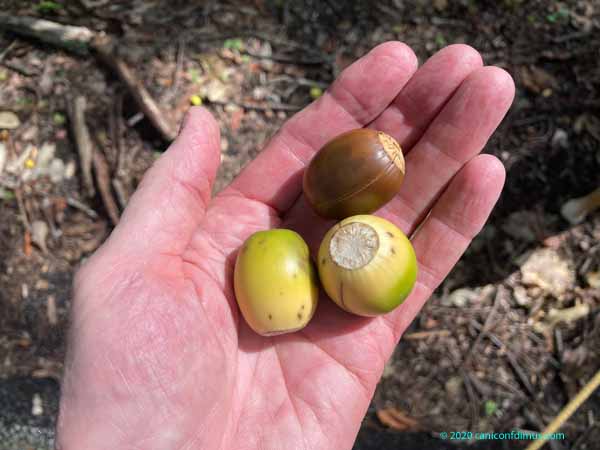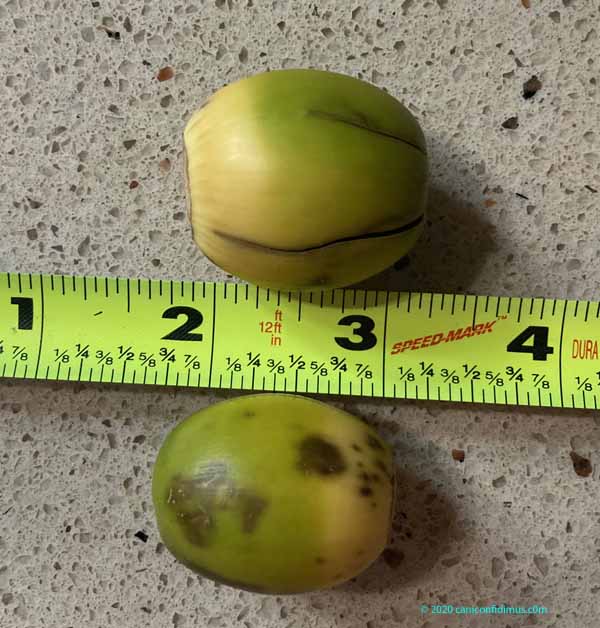Apparently, from what I can find, autumn is called fall for the exact reason you might think it is — this is the season when leaves fall.
But not only leaves. When I was walking the dogs a few days ago, we came into an area where a lot of large oak trees overhang the road. These were falling from the trees.

A lot of them were falling. I could hear them hitting the leaves, and I could hear them hitting the road around us. I thought about recording the sound of falling acorns, but, even though they were falling frequently, I figured I wouldn’t be able to get a good recording. Oaks are pretty shy about that kind of thing.
I think we were all fortunate that none of them hit us.
These acorns come from the chestnut oak (Quercas montana), the most common oak around this part of the mountain. The chestnut oak itself is quite common from Massachusetts all the way down the mountainous spine of the East to Mississippi. It has a cousin, the swamp chestnut oak, which grows in lowland areas, as opposed to our chestnut oak, which, as its name implies, grows in higher elevations.
Our chestnut oak’s acorns are among the largest in the US.

The Wikipedia article says the chestnut oak acorn ranges in size up to around 1 1/2 inches. As you can see, one of the acorns I picked up from the road is around that size. The swamp chestnut oak’s acorns may be larger (or maybe not). The bur oak’s acorns are said to be larger, but bur, or burr, oaks don’t grow around here.
These are good throwing acorns. They are also useful as chew toys for dogs, although apparently the taste discourages them from chewing too long. Wildlife find them appetizing. There are other places along the road where squirrels have had a picnic and left all the chewed up skins on the road. The acorns of the white oak group, of which the chestnut oak is a member, have less tannins and are therefore less bitter than acorns from the red oaks. I don’t really know because I haven’t sampled them.
Another thing the Wikipedia article says is that the wood of the chestnut oak is dense and makes good firewood. I have found that to be true, second only to the dogwood, I think. A few years ago we cut several large oaks that were threatening the garage at our old house, and they burned well. It is not uncommon to see several trunks sprouting from the same spot, which tends to make them somewhat weak as they get bigger. For that reason I cut any that were close to the house. At our new house we have mainly pines and maples, so I haven’t had the chance to try much oak in our wood burning stove.
But if one of the oaks along the road had actually dropped an acorn on my head, I might have considered a little oak rustling.
I went for a walk with your father one time. He found and gave me a buckeye. He told me it would bring me good luck. I carried that with me for years in the bottom of many purses before it mysteriously disappeared. I guess I used up all the luck. I just recently learned they are related to chestnuts. However, the chestnut has three fruit inside where the buckeye has only one. There is also a great homemade treat with peanut butter and chocolate by the same name I remember making in Girl Scouts. I guess I need to teach the kids that recipe.
I definitely know when it’s fall when a few acorns hit the metal roof of my cabin!
Wow. Those are mighty big acorns. I definitely would not want to get hit in the head by one of those. I’m sure the squirrels enjoy this reliable fall picnic. We don’t see many acorns here or fall colors. Just a dimming of the light in the green forests.
Debra — Ahh, peanut butter and chocolate, natures two most perfect foods. I think it would be a good idea to teach the kids how to make buckeyes. I’ll let you know when I can be out there.
Paul — Our old house had a metal roof. There were two oaks next to the house (they leaned away from the house). We could hear the acorns hit the roof through the ceiling and insulation. Bang! Rattle-rattle-rattle.
Robin — That sounds really northern. I can almost see it.